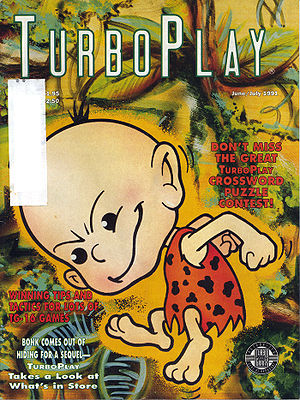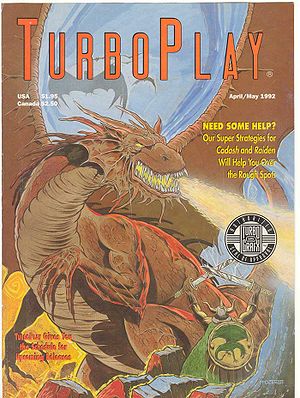
TurboPlay
Encyclopedia

Video game console
A video game console is an interactive entertainment computer or customized computer system that produces a video display signal which can be used with a display device to display a video game...
s, especially the North American models: TurboGrafx-16
TurboGrafx-16
TurboGrafx-16, fully titled as TurboGrafx-16 Entertainment SuperSystem and known in Japan as the , is a video game console developed by Hudson Soft and NEC, released in Japan on October 30, 1987, and in North America on August 29, 1989....
(PC Engine), TurboGrafx-CD (TG-CD), Turbo Duo (DUO) and the handheld TurboExpress
TurboExpress
The TurboExpress or PC Engine GT in Japan was a portable version of the TurboGrafx-16/PC Engine , released by NEC in 1990 for $249.99 .It was the most advanced handheld of its time and could play all the TurboGrafx-16's games The TurboExpress or PC Engine GT (Game Tank) in Japan was a portable...
(PC Engine GT). NEC's SuperGrafx
SuperGrafx
The SuperGrafx video game console is an upgraded version of NEC's popular PC Engine system. At first it was known as the PC-Engine 2—which was purported to be a true 16-bit system with improved graphics and audio capabilities, not expected to see release until 1990...
(which was never released outside of Japan) also received some minor coverage.
Each 32-page issue featured software/hardware reviews and previews, strategy guides and cheats, letters to the editor, one or two feature articles and contest announcements. These bi-monthly contests often required folks to be creative (as writers or artists) and winning entries were awarded one (1) Grand Prize (typically five TG-16 software titles) and five (5) Runners Up (typically one TG-16 software title).
Feature articles ranged from coverage of trade shows (CES, Tokyo Toy Fair) to behind-the-scenes peeks at game development (i.e. interviews with actors during the filming of FMV (full motion video
Full motion video
Full motion video based games are video games that rely upon pre-recorded TV-quality movie or animation rather than sprites, vectors, or 3D models to display action in the game. In the early 1990s a diverse set of games utilized this format...
) sequences for the TG-CD It Came From the Desert
It Came From the Desert
It Came from the Desert is a 1989 computer game by Cinemaware. It was originally released for the Amiga, but later ported to other systems, as well as released in distinctly different forms to consoles....
; interviews with the ICOM development team that created the TG-CD Addams Family).
Both HuCard (TurboChip) and CD-ROM (TG-CD) games were reviewed. Since the TG-CD library was relatively small, the bulk of reviews cover the HuCard format games. The format of the game reviews changed over the course of the first few issues: initially games were not given a quantitative score (issues #1 & #2), then games were graded on a scale of one to five stars (five being the best, issues #3 & #4), finally, with issue #5, TurboPlay adopted VG & CE's standard format for reviews (i.e. games were given individual scores -- on a ten-point scale -- for Sound/Music, Graphics, Playability and "Overall").
NEC did not produce TurboPlay, and thus did not have editorial control over its content, but NEC was the primary source of advertising revenue (NEC agreed to purchase at least 4 full-page ads in each issue, "indefinitely"). As a result, NEC's ads dominated the pages of TurboPlay, although one could also find ads for mail-order companies and a small roster of third-party publishers: Tengen (KLAX), Radiance Software (Sidearms), IGS (Sonic Spike, CyberCore, Sinistron, Tricky Kick), and Working Designs
Working Designs
Working Designs was an American video game publisher that specialized in the localization of Japanese console role-playing games, strategy video games and top-down shooters for various video game platforms. Though the company had published many 'cult hits', it was known best to fans as the...
(Cadash, Parasol Stars, Cosmic Fantasy 2, Exile, Exile 2, Vasteel).
Publication history and personnel

Spin-off (media)
In media, a spin-off is a radio program, television program, video game, or any narrative work, derived from one or more already existing works, that focuses, in particular, in more detail on one aspect of that original work...
magazine from the editors of VideoGames & Computer Entertainment (VG&CE), a popular multi-platform magazine of the late 1980s / early 1990s. VG&CE, like TurboPlay, was published by L.F.P. The two magazines would occasionally run cross-promotions to encourage readers to subscribe to their sister publication.
Alan Hunter, Jim McDermott
Jim McDermott (illustrator)
Jim McDermott is a New Hampshire-based artist who has illustrated for animation, magazines and comic books....
, Van Arno and other illustrators supplied the cover (and interior) art for TurboPlay.
Lee Pappas and Andy Eddy
Andy Eddy
Andy Eddy is an American video game journalist and critic. He currently resides in Redwood City, California.- Biography :Eddy was the executive editor of VideoGames & Computer Entertainment in the late 80s and early 90s, followed by tenure as a senior editor at GamePro magazine...
(respectively, publisher and executive editor of VG&CE) lent their talents to TurboPlay, as did many other VG&CE staff / reviewers. Notable writers for TurboPlay included Victor Ireland (of Working Designs
Working Designs
Working Designs was an American video game publisher that specialized in the localization of Japanese console role-playing games, strategy video games and top-down shooters for various video game platforms. Though the company had published many 'cult hits', it was known best to fans as the...
fame) and Donn Nauert (a video game record holder). Donn Nauert was senior editor of TurboPlay for the first twelve issues, with Chris Bieniek taking over the reins for the final two issues.
Donn Nauert, a celebrity of sorts in the gaming community (at the time, he held many video game "high score" records in the Guinness Book of World Records and was a member of the short-lived "US National Video Game Team", wrote many of the feature articles for TurboPlay, in addition to the strategy guides that appeared in nearly every issue.
Victor Ireland, another up-and-coming "celebrity" in the gaming community (he convinced the owner of Working Designs
Working Designs
Working Designs was an American video game publisher that specialized in the localization of Japanese console role-playing games, strategy video games and top-down shooters for various video game platforms. Though the company had published many 'cult hits', it was known best to fans as the...
to enter the video game market and begin localizing popular titles for TG-16, TG-CD, Sega CD and later, Sony PlayStation platforms) also contributed regularly to TurboPlay. Beginning with issue #4 (Dec. 90 / Jan. 91), Victor Ireland wrote "Games Around the World", a regular column that profiled PC-Engine games available in Japan. He also covered many trade shows and even penned a feature article on "The Sound and Vision of CD+G". [ CD+G
CD+G
CD+G is an extension of the compact disc standard that can present low-resolution graphics alongside the audio data on the disc when played on a compatible device...
-- audio compact disc + graphics -- was a relatively new format supported by high-end CD players, TurboGrafx-CD, and later, the Sega CD.]
Initially, the software reviews in TurboPlay were uncredited, but eventually the authors were acknowledged. Some reviewers from VG & CE (Chris Bieniek, Clayton Walnum, Donn Nauert, etc.) were commissioned to write reviews for TurboPlay as well. Donn Nauert and Chris Bieniek eventually became permanent staffers at TurboPlay.
Importance of TurboPlay to the TG-16 gaming community
During the 16-bit16-bit
-16-bit architecture:The HP BPC, introduced in 1975, was the world's first 16-bit microprocessor. Prominent 16-bit processors include the PDP-11, Intel 8086, Intel 80286 and the WDC 65C816. The Intel 8088 was program-compatible with the Intel 8086, and was 16-bit in that its registers were 16...
console wars
Console wars
"Console wars", also known as "System wars" is a term used to refer to periods of intense competition for market share between video game console manufacturers. The winners of these "wars" may be debated based on different standards: market penetration and financial success, or the fierce loyalty...
, TurboGrafx-16 struggled in the North American market and, as a result, was given marginal coverage in the major multi-platform magazines of the day. By default, TurboPlay was the only resource Turbo fans could turn to for more in-depth, consistent and timely coverage of TG-16 domestically and PC-Engine in Japan. Ultimately, it proved to be the most successful North American publication dedicated exclusively to NEC's consoles (see below for related TG-16 publications).
External links
- TurboPlay Magazine Archives (TurboGrafx-16) , offering page scans for all issues of TurboPlay Magazine as well as TurboForce and DuoWorld (subsequent TG-16 magazines).
- Jim McDermott official site
- Interview with editor Chris Bieniek

